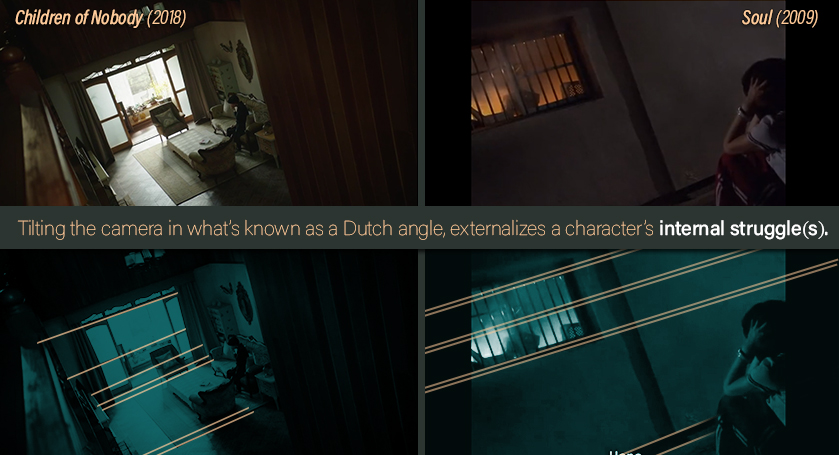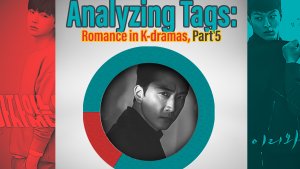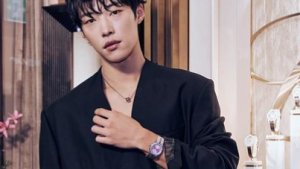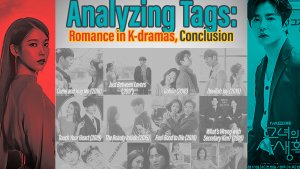 A Tag Analysis: Romance in K-Dramas - Conclusion
A Tag Analysis: Romance in K-Dramas - Conclusion

Welcome to part three of the Popular Visual Cues in K-Dramas series. For those who missed the previous parts, you can check out this handy index below:
INDEX | |
|---|---|
| PART ONE (read here) | Covered two of the most common cues used to establish interpersonal relationships. |
PARTS TWO - FOUR Will cover two of the most common interpersonal cues. Meaning, cues used to establish a character's state of mind or his/her "process of introspection". The fourth article will cover several examples where more than one cue is being used in a scene or shot. | |
| PART TWO (read here) | Interpersonal Cues: Boxing |
| PART THREE (current article) | Interpersonal Cues: The Dutch Angle |
| PART FOUR | Interpersonal Cues: Overview |
POPULAR MOTIFS IN K-DRAMASThis will be a different series of articles but on a similar vein. These sets will cover prevalent motifs used in k-dramas to build an additional narrative within the story. I'll be covering one motif and it's variations per article. Once I start working on them, the structure may change. | |
| PART ONE | Popular Motifs in K-Dramas: Mirrors, Windows & Reflections |
| PART TWO | Popular Motifs in K-Dramas: Rain, Water & Submerging |
| PART THREE | Popular Motifs in K-Dramas: Feet, Shoes & Direction |
Except for part four, each article will be independent, so you don't need to read the previous one in order to understand this one. Having said that, I encourage you to check out the other articles since they'll give you insight into techniques that may increase your appreciation and enjoyment of K-dramas.
With that said, let's kick off the third installment by looking at different ways K-dramas make use of a technique called the "Dutch angle".
This set covers a technique used to externalize a character'sSTRESS, TENSION &/OR INSTABILITY.('+﹏+') |
This article will focus on the implementation of the "Dutch angle" (also known as the "Dutch tilt" or "oblique angle") within K-dramas and a C-dramas (I've just started to get into them). The "Dutch angle" is a type of camera shot wherein the horizon line isn't parallel with the bottom of the camera frame, producing a viewpoint akin to tilting one's head (see the comparison below):
DUTCH VS NORMAL ANGLE |
 |
Unlike the cues covered in previous articles, this one is prevalent worldwide. This technique was conceived during the First World War by German cinematographers who took part in the expressionist movement. Therefore, "Dutch" refers to a bastardization of the word Deutsch (which means "German"), not to the Dutch people.
Cinematographically speaking, the Dutch angle is used to portray a character's psychological uneasiness or tension.
In this article, I'll use scenes/shots from K-dramas (and one C-drama) to showcase the different meanings the technique can convey. So with that said, let's take a look at some examples:
FEAR | |
Children of Nobody | Soul |
These examples are the perfect way to tie a visual to the popular idiom "someone pulled the rug out from under me". The tilted angle in combination with the character's body language (isolated, tensed and hunched) transmits the feeling of being left, abruptly, in a problematic or difficult situation. Both of these characters are facing something unbearable. So the unnatural angle conveys they've become mentally and/or emotionally unbalanced.While the example on the right is rather obvious, the one on the left isn't. This scene from Children of Nobody takes place after an awkward conversation this mother had with her stepdaughter. The characters already have a strange relationship so the curt conversation seems almost natural. However, as the mother is left alone in the room, the camera zooms out and tilts, silently conveying this withdrawn character is actually feeling shaken. | |
UNSURE | |
The Crowned Clown | The Last Empress |
The Dutch angle builds a feeling of uncertainty in both examples; albeit for different reasons.On the left, we see Royal Officer Jang Moo Young looking into a deep hole in the ground. The angle doesn't just convey the uncertainty of what he was forced to do, but also the emotional stress he's under. If you've seen the show, you know Officer Jang was pretty much caught between a rock and a very hard place. The tilted angle simply hints that what he's done has left him apprehensive. On the right, two main characters share the frame, so the Dutch angle can contribute a narrative for both. On the floor, Oh Sunny (the FL) hugs and comforts a woman who's going through a similar situation she's in. The angle shows her inability to come to terms with her feelings, which result in becoming emotional unbalance. Standing behind them, Wang Sik (the ML) also struggles to come to term with his feelings. Specifically, in regards to his role in instigating Oh Sunny's predicament. Therefore he too is feeling torn between his feelings and his mission. | |
EXTREME UNCERTAINTY |
The Crowned Clown |
A long overdue confrontation between characters might climax into a steep Dutch angle. Even without context, the tension in this shot is evident and palpable. The more oblique the angle, the more anxiety is transmitted to us, the audience.The longer the shot is, the more it perpetuates a sense of disharmony, disorientation, and conflict. Which is exactly what the director has chosen to do with this example, amplifying our anxiousness by shooting the characters with this angle, for a long period of time, while the characters say nothing. We get the impression, right away, that the relationship between these characters has become precarious and that, at any second now, their reality "might collapse in on itself". While the director has made it apparent that an important change has just taken place, it also leaves us wondering what the new panorama will look like once this conversation is over. The fact that this is actually the last shot of an episode makes it a perfect cliffhanger, ensuring you'll tune in next time to see if they will managed to overcome this monumental obstacle. |
CONFUSION | |
 | |
The Dutch angle can be also be used to externalize a character's confusion. | |
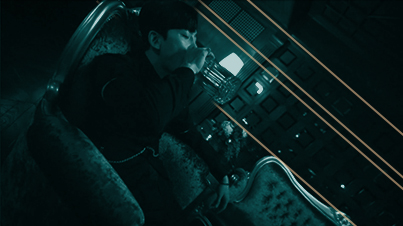 |  |
The Last Empress | Legend of Fu Yao |
By having the camera roll on its axis during a scene, it creates and effectively communicates a feeling of confusion and/or dizziness.This confusion wouldn't come across as successfully if the camera were to shoot the actors normally. Creating this effect is so popular, you've probably seen it in 2D animation as well. However, just because they both give a sense of confusion, doesn't mean that it's brought about by the same circumstances. On the left, Emperor Lee Hyuk's (the 2ML's) confusion is a result of his inability to trust those close to him. Believing he's been lied to, he feels untethered and shaken, which the camera portrays by swirling around him like a pestering fly. Of course, the dim light and his dazed look contribute to the portrayal of his emotional and mental imbalance. On the right, Fu Yao (the FL of a C-Drama) is attacked by a strange witch while trapped in a "magically induced" nightmare. Her dizziness is, therefore, the result of the antagonist's magic; not her inability to come to terms with something. Although, if things are happening in her dreams, then we can't really disregard a link to the state of her psyche. But that would be up to interpretation. | |
GRIEF | |
The Last Empress | Legend of Fu Yao |
Of course, there are times when the Dutch angle is used to amplify the grief of one or several characters. And it makes sense because the angle introduces a feeling that there's a new order to the world. Meaning that, now that the character(s) has lost a pillar of strength, their world is collapsing, leaving them shaken and unstable. | |
STRESS | |
 | |
 | |
The Last Empress | While You Were Sleeping |
Whenever two characters are having a confrontation and one of them lashes out against the other one, the director may choose to insert a Dutch angle. In these cases, the angle doesn't just dramatize the scene, but it also showcases that one character is "losing his cool" and acting on instinct. | |
UNRAVELING | |
 | |
The Dutch angle can be implemented during the shot to show that a situation is about to get dramatically complicated. | |
The Last Empress | |
If the camera tilts as a character enters the scene, it may signify an oncoming problem. In this case, since both characters are protagonists, the narrative created by the angle can apply to both. On one hand, it dawns on Wang Sik (the ML) that he's just stepped into a trap as his world tilts and changes. On the other, Wang Sik's urgency has confirmed Lee Hyuk's (the 2ML's) fears; so his reality also gets warped. Both of them would need to figure out what the new state of their relationship is. The rolling camera, thus, externalizes their stress, realization, and apprehension as the situation unravels. | |
A RED FLAG | |
 | |
 |  |
Sometimes the Dutch angle can be used as a red flag hinting that something's wrong. | |
King2Hearts | The Light in Your Eyes |
| On the left, we have our main leads meet after a while of being apart. The director makes it a point to tie a camera to each character; giving the shot a POV. So when a stern and cold looking Hang Ah (the FL) walks in, it's Jae Ha (the ML) who picks up the signal that there's something wrong. On the right, we see a conversation between Hye Ja (the FL) and Young Soo (her older brother). Notice how as Young Soo reaches out to comfort her, the director tilts the camera. In so doing, we get the sense that this behavior from Young Soo isn't usual and Hye Ja, thus, suspects something's fishy. In both cases, the tilted angle externalizes a character's stress and confusion at being confronted with a strange, atypical or unknown situation. | |
DOMINANCE | |
 | |
 | |
Haechi | |
The Dutch angle can also contribute to adding menace or showing the dominance of one character over another. This is accomplished by using the oblique angle in addition to shooting the subject at a low angle. The result is that the characters look bigger, stronger and more menacing.The effect is more obvious on the left since we are looking at Prince Lee Geum (the ML) from Prince Lee Tan's (the antagonist) perspective. The low angle makes the former look almost unreachable. While the Dutch angle indicates the latter is feeling overwhelmed. The stress relayed by the Dutch angle only corresponds to Lee Tan because the camera has been tied to his POV. On the right, the effect kicks in by how the director inserts it. We have a conversation where characters are shot with a normal angle. Then suddenly, we cut to the Inspector who's shot at an oblique and lower angle -- adding power to his words. This scene is interesting because as the conversation progresses, other characters get this treatment as well. Which helps us realize there's a power-struggle happening. | |
ADDING TENSION TO AN ACTION | |
 | |
The Dutch angle can be also be used to give impact to a character's physical action. | |
 |  |
Fight for my Way | Legend of Fu Yao |
Sometimes the Dutch angle can be used as a way to dramatize a fight.On the left, notice how the angle gives the fighter's punch a more dynamic feel; like he's so heavy, the world is tilting. On the right, the director tilts the camera when Zhuzhu (the 2FL) performs a move. This not only adds impact to her slash, but it also distracts the viewers from noticing the flaws in the choreography. Because if you take a closer look, you'll see that there's a delay between her slash and the stunt-man's air twirl. The shaking camera also allows us to feel like we're in the middle of the action. Keep an eye out for the integration of this angle during dramas that feature fights. | |
ADDING TENSION TO A PAUSE |
 |
Lawless Attorney |
This example shows how the Dutch angle can add psychological tension to a pause. Here we get a showdown between Bong Sang Pil (the ML) and an antagonist who's taken Ha Jae Yi (the FL) hostage. Bong Sang Pil gets bombarded with flashbacks of a time when something similar happened and things didn't turn out so good. So the camera tilts to the side, adding weight to Bong Sang Pil's side. Since this is a moment he must overcome, the effort to climb this metaphorical hill should lay with him.Of course, the light and low angle help to create a sense of danger. But it's the tilted camera that really elevates the composition to a whole other level. |
ADDING TENSION TO A CONVERSATION | |
 | |
The Dutch angle can be inserted into conversations to emphasize a character's hostility or apprehension without having to spell it out. | |
 |  |
While You Were Sleeping | The Light in Your Eyes |
This one is so subtle, you might miss it if you're not paying attention. Not only does the Dutch angle gets inserted for only a few seconds, but if it's a close shot of a character, then it can be even more difficult to consciously detect (but trust me, unconsciously, you picked up on it). So remember to pay attention to the background. Even if it's brief, your eye will catch the tilted line and communicate the angle to you.On the left, the conversation would play out quite differently if not for the Dutch angle. By shooting his response with an oblique angle, we pick up on the hostility behind the softly spoken observation. As the angle indicates, things aren't "okay." In fact, even without sound, you can still pick up that "something's fishy" feeling in the gif above, don't you? | |
And that's it for this subject! Thank you for reading and, if you've also read the previous articles, thank you for your interest! If you have the time and inclination, I'd love to read your thoughts in the comments down below!
Did you enjoy the article?
Here are some questions to get a conversation started:
- Did you know about this technique prior to this article?
- Had you noticed the Dutch angle before even if you didn't know what the technique was called?
- Which of these examples was your favorite?
- Where my explanations clear or did you feel like more context for each example would've helped?
- Did you like the inclusion of more gifs as opposed to stills? Or are you indifferent so long as the point is clear?
- Are there other cues related to intrapersonal relationships -- apart from Boxing and The Dutch Angle -- that you've picked up in K-dramas?
- Are you looking forward to the rest of the articles? Is there one in particular that appeals to you? Why or why not?



